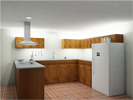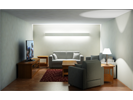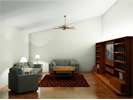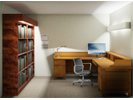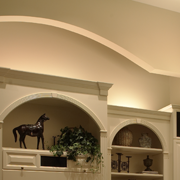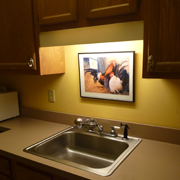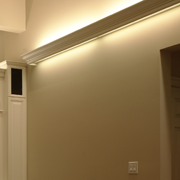
Architecturally Integrated Lighting
Architecturally integrated lighting is usually custom built by integrating cabinetry or trim with simple light fixtures, and includes coves, soffits, and valances. Coves distribute light upward; soffits distribute light downward; valances distribute light up and down. The fixtures used in architecturally integrated lighting typically contain linear fluorescent lamps (also called tubes), lamp sockets or holders, and ballasts. Some fixtures used in architecturally integrated lighting use reflectors to increase efficacy. Shields hide the light bulbs from view and can be constructed of metal, wood, or other material. Optional baffles, louvers, or diffusers can be incorporated to direct light and to reduce glare. Architecturally integrated lighting provides soft, diffuse ambient light that may need to be supplemented by task lighting. They are unobtrusive and can be incorporated into the interior design of a space.
Use architecturally integrated lighting in rooms with white or light colored walls and ceilings. Shield lamps that can be seen from normal viewing positions with baffles, louvers, or diffusers to limit glare. Paint the inside surface of the shielding boards of site built fixtures white for highest reflectance. Arrange the light bulbs inside site-built architectural fixtures so that the light is distributed evenly. If using linear or compact fluorescent lamps, consider mounting them so that their ends overlap slightly, thus avoiding gaps in light distribution. If two rows of linear fluorescent lamps are used, stagger the ends of the lamps.
Switch the fixtures on each wall separately for convenience and energy savings. If each fixture contains two rows of lamps, wire them for separate row switching to achieve two levels of light output. Consider dimmers for linear fluorescent lamps, but remember that special ballasts must be used.
Coves direct light upward and use the ceiling as a reflector to distribute light indirectly throughout the room. Consider coves for rooms with high ceilings, including vaulted or cathedral ceilings, or with low ceilings (e.g. basements) to make the space seem less constricted. Use coves to emphasize decorative ceilings. To prevent hot spots or excessive brightness on the ceiling, place the top of the cove at least 18 inches from the ceiling; position the base of the cove at least 6 feet, 8 inches above the floor. For kitchens without soffit enclosures above the upper wall cabinets, simple fluorescent lamp holders can be mounted on top of the cabinets and concealed from direct view with a trim board. This provides ambient lighting for the kitchen and it can be supplemented with under-cabinet fixtures or other task lighting. To reduce glare, the cove shielding board should hide the lamp from view while allowing the lamp to light the ceiling directly.
Soffits, sometimes referred to as cornices, are architecturally integrated lighting that direct light downward only. They can produce dramatic lighting effects on walls, draperies, and murals. Soffit lighting produces a grazing effect that enhances textured surfaces such as wood, brick, and stucco. Soffits can be used in rooms with low ceilings, and can be integrated into cabinetry, particularly in kitchens and bathrooms where light is needed on countertops.
Valances direct light both up and down. Use linear fluorescent lamps in valances. Valance lighting can be used with ceiling heights of at least 8 feet, including vaulted or cathedral ceilings. Valance lighting is a good choice for living rooms, bedrooms, and kitchens. Consider a lower valance mounting height for lighting specific tasks such as reading in bed. The downlight component of a valance light is used to wall wash and can be used effectively above draperies. Mounting height will vary to coordinate with window and door height. Consider aligning the valance height with the top of the doors and windows, typically at 6 feet, 8 inches. Valances can run continuously along a wall.
Cautions
- Because architecturally integrated lighting is installed close to walls or ceilings, grazing light from these fixtures may accentuate imperfections and any other textures on those surfaces.
- If a landing or balcony overlooks a room with coves, shield the cove lamps from view from above.
Example Patterns
